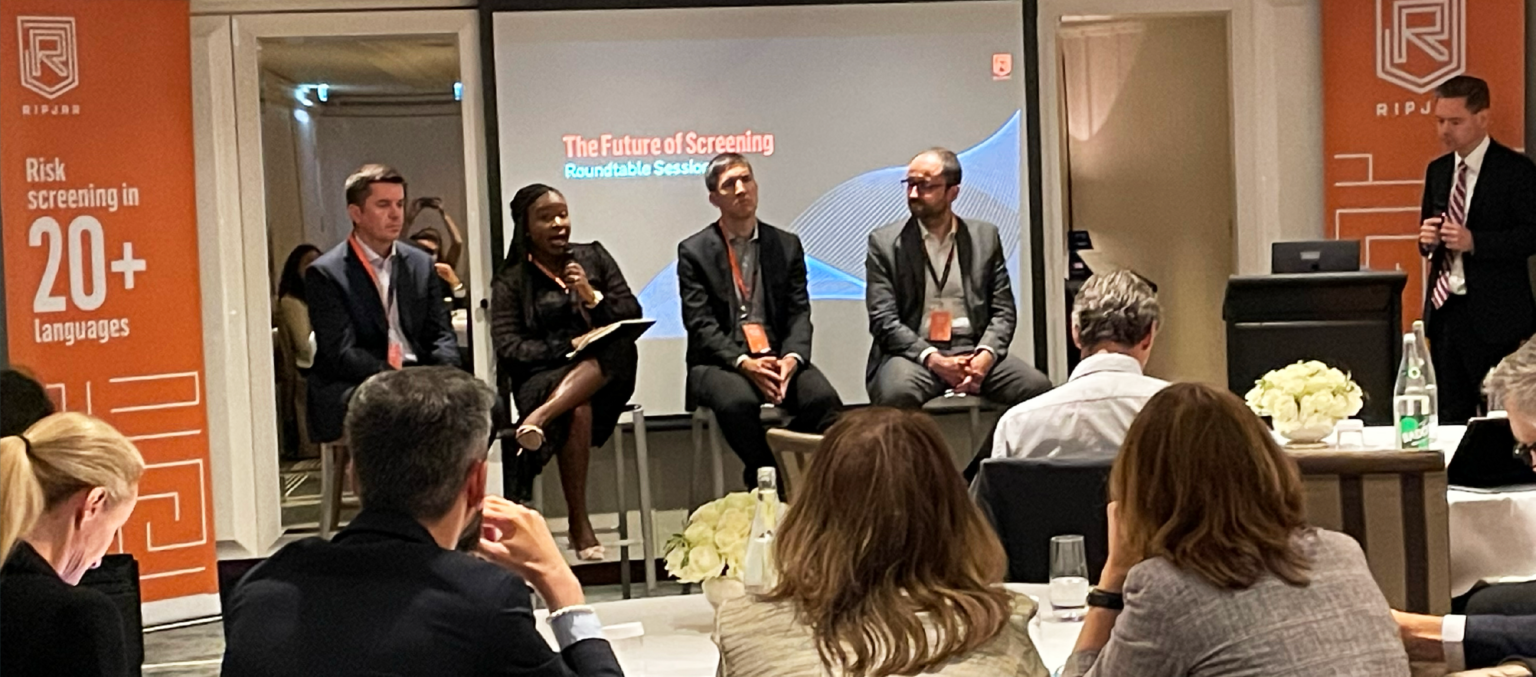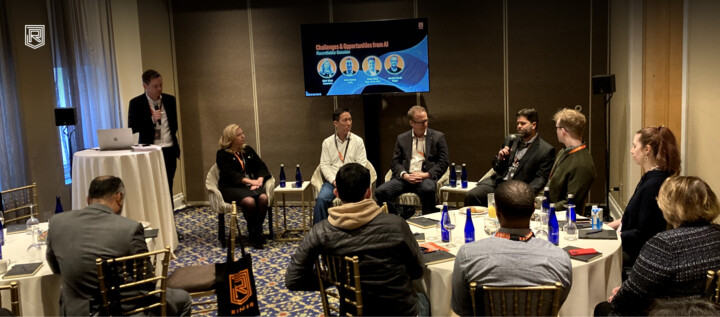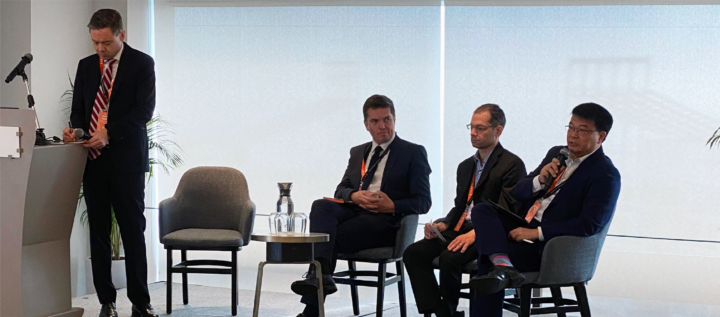In June 2023, Ripjar brought together senior compliance professionals from banks and financial institutions operating in France and around the world, for an event at the Peninsula Hotel in Paris. Situated in the heart of the French capital, the second Ripjar Summit included a luxury networking breakfast, live demo of Ripjar’s new AI Risk Profiles solution, and an expert panel discussion of current screening challenges and trends.
The panel discussion involved international compliance and financial technology experts, with a focus on customer and counterparty screening challenges, and on how screening and compliance will change in the future. The panellists included Jérôme Grelier (Partner Manager Director at Accenture Consulting), Vera Akiotu (Director of Financial Crime Compliance Proposition at Dow Jones), Bertrand Bouquet (Head of Process Leader for Screening & Filtering at BNPP), and Simon McClive (General Manager of Labyrinth Screening at Ripjar). The discussion was moderated by Ripjar’s Chief Product Officer, Gabriel Hopkins.
Let’s explore some of the key points and insights from the Ripjar Paris Summit panel discussion:
What regulatory changes are we seeing in screening frameworks in Europe and around the world?
Bertrand Bouquet opened the discussion with a European perspective on recent regulatory screening changes. He pointed out that the fundamental customer screening regulations have broadly stayed the same in recent years, with regulators maintaining a high expectation for technical compliance. Bouquet pointed out that efficiency is key to managing regulatory change in this environment – a challenge which can quickly add to a firm’s administrative burden. He stressed that firms must be deeply invested in, and consistent with, their screening compliance efforts in order to achieve the required level of efficiency, and adapt to new challenges.
Adding to Bouquet’s thoughts, Jérôme Grelier mentioned the EU’s new Anti-Money Laundering Authority (AMLA), which will begin operations in 2024. Grelier characterised AMLA as the “beginning of a new era” and suggested that while the regulator would not necessarily make drastic new regulatory provisions, it would focus on tackling the anonymity of financial criminals as part of its approach to screening, targeting in particular beneficial owners, and the use of digital assets such as cryptocurrencies.
Grelier noted that one of AMLA’s objectives will be the further harmonisation of regulations across Europe as a way of addressing compliance weaknesses, raising compliance standards, and making data sharing and collaboration easier.
How has the invasion of Ukraine changed attitudes to customer screening, and how have institutions responded?
Vera Akiotu pointed out that the conflict in Ukraine has created an unprecedented challenge for compliance teams around the world, thanks mainly to the sheer volume and frequency of new sanctions, and the coordination with sanctioning bodies. Akiotu highlighted the particular challenge of identifying Russian shell companies, and the administrative burden of dealing with the multitude of sanctions not only against the Russian state, but against Russian individuals.
Simon McClive characterised the Russian invasion of Ukraine as a “step change” which had generated an enormous amount of work for financial institutions. He cited an example bank that previously had to screen around 180 Russian individuals and 53 Russian organisations prior to the invasion, but that now had to screen over 1,500 individuals and over 200 organisations. McClive noted that the speed and intensity of the new Russia sanctions had forced a collective mindset shift in financial institutions, which had to find ways to deal with an influx of new names and entities, and a spike in false positive alerts.
The Ukraine situation has also prompted financial institutions to think about the wider geopolitical landscape. McClive mentioned China and Taiwan as an area of growing concern, and the need for firms to gauge their preparedness for new sanctions in event of future conflict. In this environment, firms should think carefully about how to prioritise sanctions compliance resources, and rely on technology to mitigate unexpected burdens.

What new sanctions screening considerations might emerge in the next couple of years?
Reiterating the prospect of a China-Taiwan conflict as a significant sanctions concern, Simon McClive pointed to the significant exposure of Western firms to supply chain and wealth management risks. He highlighted the production of semiconductors across China as a likely sanctions target – an issue that has led many firms to begin sourcing the technology in the US and Europe.
Vera Akiotu noted that Russia sanctions aren’t going away and, in fact, are likely to expand in the future. She suggested that India and Singapore are territories to watch, as a result of their connections to the Chinese economy, but that these countries have also demonstrated a desire to build connections with the West. Akiotu also mentioned the particular danger of sanctions evasion in countries like Kyrgyzstan in the CIS region.
What role does AI play in compliance?
Jérôme Grelier noted that AI can play a variety of compliance roles but highlighted the technology’s potential for enhancing customer screening processes, and reducing false positive ratios, by helping to identify and extract the most relevant information from data. Grelier pointed out that AI tools could be used to fully automate low level screening tasks (such as data collection), and to allocate AML/CFT alerts to the right teams quickly and efficiently.
Bertrand Bouquet also acknowledged AI’s potential to improve screening, but stressed the importance of understanding how to deploy AI across a compliance infrastructure, and of building the right team, with the right skills, to manage it. Bouquet pointed out that financial institutions must apply scrutiny when selecting AI use cases, to ensure “progressive and adequate mastering of those solutions”. He noted that AI solutions must remain under control at all times, be reactively configurable, and be “explainable” to regulators in compliance contexts, especially with regards to sanctions programmes.
Vera Akiotu echoed this sentiment, noting that “AI can’t achieve everything on its own. It’s bringing in that human expertise with AI and automated solutions that gives the true output that organisations can rely on.”
How should financial institutions balance AI tools such as Chat GPT with customer screening processes?
Simon McClive referenced “explainability” as a critical factor in the integration of AI in customer screening. He highlighted the phenomenon of “hallucination” in which generative AIs such as ChatGPT create false data points that “look plausible” (such as customer dates of birth) but that are seemingly manufactured by the predictive language model the tool is using.
While that kind of output is undesirable, McClive pointed out that AI tools are particularly effective at digesting and summarising large amounts of information. He noted specifically the importance of training AI models extensively on large volumes of high quality data while considering the types of issues that might affect language models, especially in terms of addressing regional risks. By bringing together rich, relevant datasets with Large Language Models, McClive suggested it would be possible to generate highly accurate, succinct summaries of risk that could revolutionise the way banks and other organisations conduct their screening. Bertrand Bouquet echoed that sentiment, characterising the potential impact of the technology of AI as “a matter of training and monitoring”.
Jérôme Grelier cited the capability to read any type of documents as one of AI’s most disruptive applications in compliance contexts, especially if tools could be tasked with reading and understanding human language. That capability could provide a huge efficiency boost for screening, and be used, for example, to pre-generate forms and customer profiles.
Using AI Risk Profiles in Adverse Media Screening
In addition to the panel discussion, Ripjar’s Head of Operational Data Science Abhijith Rajan gave a presentation on the Labyrinth Screening platform and the potential impact of AI Risk Profiles technology in adverse media screening.
In an increasingly complex compliance environment, many regulators are pressuring firms to integrate adverse media into their screening solutions as a way to better capture risk and enhance the quality of financial intelligence. Labyrinth’s AI Risk Profiles technology has been developed to help firms step up and meet these new challenges, even as the landscape evolves.
Extracting Relevant Data
Adverse media searches take in potentially billions of data sources, across different language systems, and with varying degrees of credibility. In developing Labyrinth Screening, Ripjar realised that firms needed a way of resolving entities from the vast amounts of collected data: for example, if an article had information on 5 people and 2 organisations, an adverse media search would ideally be able to identify each entity – and produce relevant data for searches concerning a given individual. The sheer volume of similar stories relating to a particular entity can also be a challenge: customer name searches might generate tens of thousands of articles, (especially for common names), and so add a significant amount of work to the compliance burden.
A Step Forward
To address the challenges of adverse media searches, Ripjar took a step forward by developing AI Risk Profiles. Rather than solely looking for media articles, AI Risk Profiles reverse the process to search for the people in those articles. As Abhijith Rajan described it: “We’ve pivoted away from presenting news media and we’ve now generated entities that are linked to this unstructured data.”
By building AI Risk Profiles for particular entities, firms can bring together a range of data sources, including watchlists, media stories, and private networks, and even connect the profile with other organisations and risk factors. Abhijith Rajan used the example of the name ‘Richard Ferrand’, referring to both a US citizen involved in an armed confrontation, and the former president of the French National Assembly. The AI Risk Profiles solution was able to set out the risk factors associated with each individual. For the French Richard Ferrand, the entity profile included his politically exposed person (PEP) status, relevant watchlist information, and his network connections, including friends and relations. Each profile includes links to relevant media stories, organised by the most recent involving the specific individual.

Reducing the Compliance Burden
The ability of Ripjar’s AI Risk Profiles to vastly simplify the search for risk brings significant operational benefits. Rajan used a real-world case of a company that conducted an evaluation of the solution. They set out to compare the experience of searching for risk for 77 different identities in AI Risk Profiles to the same search conducted in an article-based system where the Risk Profiles technology was not used.
Without AI Risk Profiles, searching for the chosen identities produced just under 83,000 individual news articles. Analysts reviewed the articles to identify risk and were able to find 85% of the expected identity-risk combinations.
Adding the AI Risk Profile technology was a game changer. Searching for the same identities returned 685 profiles and a subsequent review of the profiles highlighted 90% of expected identity-risk combinations.
While all the risks had been present in both experiments, analysts were simply unable to find the needle in a haystack when presented with the non-profile result set – providing an increase in effective recall (a mathematical measure of success) of 5% while reducing the volume of results that analysts had to review by over 99%.
The evaluation demonstrated the effectiveness of AI Risk Profiles technology, which surfaced risk data that would otherwise have been missed in an article-based name search.
Exploring Risk Profiles
Abhijith Rajan showcased a range of risk profiles generated for challenging names, and used the example of former UK Prime Minister David Cameron – both a famous and a common name. On review, the profile for the former Prime Minister himself included names of friends and close associates (such as current Prime Minister Rishi Sunak), and referenced thousands of relevant media stories.
The demonstration then set out profiles of other examples of individuals named ‘David Cameron’ from around the world. These profiles were distinct from the former Prime Minister’s, including only risk data relevant to those individuals, rather than the thousands of media stories relating to the British politician.
Using an example of a banking unit in the US, Rajan pointed out that Ripjar’s AI Risk Profiles is saving around 2.6 million minutes of analyst time per year – equivalent to the work of around 21 full-time employees.
Discover Labyrinth Screening
As the global risk landscape changes, Labyrinth gives you the power to meet screening challenges as they emerge. The Labyrinth Screening platform enables firms to search thousands of watchlists, news stories and other data sources, in over 20 foreign languages, and generate accurate, actionable intelligence in seconds. Ripjar’s AI Risk Profiles help your team extract the most relevant AML data from a crowded, complex landscape, and make strong, effective compliance decisions for every customer.
To learn more about how Ripjar can help you manage compliance challenges, get in touch today
Last updated: 6 January 2025





